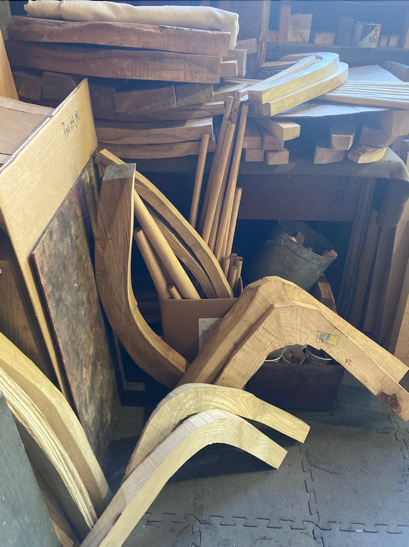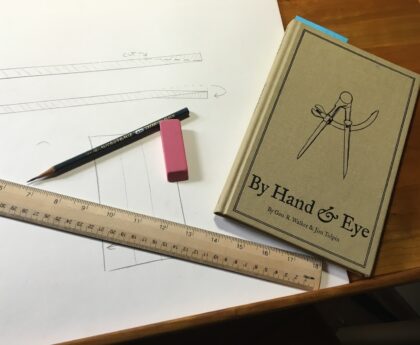by Brian Crawley
John Porritt recently gave a stick chair talk in Austerlitz, New York (click here to read about it). With so many of his chairs gathered in one place, I was able to take some quick photos of John’s different approaches to armbows. The joints are all based on those he has seen in traditional Welsh pieces. I’ve added a few more comments, too, on how he fashions sticks, legs, tenons, seats etc., intended less as prescription than permission to explore. Given that so many Welsh chairmakers look to have figured things out for themselves, there are an endless variety of solutions to be found, both within the tradition and outside it.
In the woods nearby, John looks out for near 90° bends he can use for armbows, and gentler bends for combs. His friends know by now to keep a lookout for him, too. If a bent branch is big enough, John can get bookmatched grain on the arms by sawing the limbs in two. But whether sawn from one limb or two, the armbow pieces need to be joined together in the middle somehow.
The two antique chairs John brought with him to the talk display two different common solutions. One has a long scarf, which stretches about 5″ across four of the chair’s six long sticks. The scarf is pegged at the center, I presume before the holes for the sticks were drilled, to help keep the assembly together. (The joint is not glued.)
The other, shorter of the two chairs uses a small square-edged half-lap, and a doubler above. There is no visible peg in the doubler, but there is a cut nail by the left side of the moulding. Maybe this is a later fix, as there is not one in the parallel position on the right. But there are several large builder’s cut nails underneath, one of which goes through the half-lap; of course the sticks going through reinforce the assembly too.
John suspects this chair may have been a lobster pot style, where the outer two sticks on each side bend inward toward a small comb. The doubler helps hold against the extra tension introduced by the bent sticks. John felt the more extreme bend of the outermost sticks of a lobster pot chair might be steamed, where the gentler bends beside it might not.

Two antique armbows, one a long scarf, the other a half-lap.
John’s chair with birch burl armbow uses the same scarf joint as the antique, pegged through the center (and glued). It strikes me that such a joint might be the first solution a self-taught woodworker might come up with, after the first time a butt joint fails on them. Though a simple joint, the two long slopes, angles matched with hand tools, are likely trickier to get right than a beginning craftsperson might imagine.

Six-stick black birch armbow, pegged scarf. (Photos by David Douyard.)
Sometimes John uses a doubler to bridge a long scarf joint. It might be called for if the grain in the arm’s bend is getting short, and will break over time, without support. Or it might be more a design choice, prompted by a visual need. John likes to consider how to bolster the confidence a sitter has in the look of a chair. (I have a light Texas ladderback chair, with a seat of woven twine. People always ask if I’m sure it will support them before they take a seat. They have no such insecurities with John’s chairs!)

Six-stick red chair, pegged scarf, doubler.
And as seen in the second antique chair, John sometimes uses a half-lap in his armbows. His joint is a bit more elaborate. The half-laps have angled outer edges, and central wedged and tapered keys to lock it together. After it is hammered home it is pegged from above once or twice, the number of pegs dependent on how deep the armbow.


Two chairs with half-laps, wedged and pegged.
It looks almost like a large timber-frame joint, and is in fact patterned after one John saw in a ridge board in a house in Wales. Another variation is a longer half-lap that extends across four sticks, not two.

A chair with a longer half-lap, wedged and pegged.
Two of the chairs John had in Austerlitz feature three-piece armbows with more elaborate timber-beam-style joinery. In both cases these joints span the middle of the armbow. The grain of these arms is too short to have stood the test of time without the extra support. The central piece has a dovetail in its bottom half; in the upper, there are angled edges at the sides, with pinned and tapered wedges at either side of the central two sticks. Tim Bailey, an antiques dealer in Nassau, New York, showed John how local German cabinetmakers from the Mohawk Valley wedged their dovetails. He admired their use of “belts and braces” (Brit-speak for suspenders!).

Eight stick chair, three-piece armbow, dovetailed, wedged, and pegged.
John’s current chair of soft maple and ash has a central insert cut from a piece of wood twice as thick as the arms. A dovetailed section abuts the arm, and a longer section above with a long-grained glue surface. I thought the upper half was a fourth piece to the armbow, but that’s a trick of the grain. It has two big locust pegs, wedged top and bottom, wide of the five sticks, down through the central piece into the arms, inspired by those German cabinetmakers. (“Belts, braces, and concrete abutments,” quipped John.) 1

Five stick chair, three-piece armbow, dovetailed, pegged and wedged.
John uses a limited tool set to make his chairs. The first stage of removing waste from a comb or an armbow is done with a band saw, one of his few powered tools. He keeps more wood than he thinks he’ll need, until late in the process. After the band saw, he uses a drawknife, not with a shavehorse, but with a big, old Record vise he uses while standing. We took turns working on the leg shown below, winded ourselves, then broke for tea.

John working on a leg with his drawknife. Note the bandsaw behind him.
John favors a Siegley or Hahn jack plane (prior to the c. 1901 acquisition by Stanley, when they still looked distinct from a Bailey plane). The iron is thicker than a Stanley, so it doesn’t flex in use. There is no chipbreaker; the lever cap, set back from the cutting edge, secures the iron. The single blade “just works better for green wood … rather than have …shavings getting jammed in there,” says John. It is also a pound lighter than a Stanley No 5.
With a very sharp blade, John uses it to shape the legs, sticks and their tenons. Next he uses one or more of several shaves. The largest of these is a Stanley cast iron shave with a cutter he has reground to work as a scraper. With diamond sharpeners, he makes two flats that meet at just under 90°. The scraper removes any tear-out left by the jack. It cuts at the arris, not with a burr. The mouth is quite open.
The block plane, a Stanley No. 60-1/2 set up as a scraper plane, further refines those surfaces. He does not round off all the flats and ridges, but leaves them for textural interest. John likes the surface to look worked, but not careless.

John’s tools. Note the surface of the finished sticks in the green box behind the bench.
A second, more recent power tool, is what John calls a planer, which I call a jointer; it’s a Craftsman pedestal model from the ’50s. (I think a Yank’s “planer” is a Brit’s “thicknesser.”) John needs to fix the Craftsman tool up, but the idea is to save some of the wear and tear on his wrists. He has a lathe, too, but rarely uses it for chairs. He did do a chair with a front turned short stick, like one of the antique chairs pictured above. John was little worried he’d managed to turn the front stick into a cricket bail; maybe there’s a design memory, akin to muscle memory?

The front sticks were turned on a lathe. Howzat!
John likes to leave the ends of tenons on his short sticks and legs a little proud – the same with pegs. Given wood movement, a perfectly flattened tenon won’t be flush with the chair’s seat or arm for long, so why fuss over it?2 John thinks the tenon’s extra height, and the mushrooming effect on its edge, gives a wedge a little extra to hold onto. He shaves them from the perimeter of the tenon toward the center, with a spokeshave set fine, or a chisel. He then burnishes them with a deer antler.

The short stick, leg and peg tenons are proud by a bit more than 1/16″, a bit less than 1/8″, which done by eye, not measured. John has kept some of the wane in this armbow.

The tenons on the underside of the seat protrude a bit further, maybe 3/16th” and are also done by eye. John likes to leave the ridges or “dawks,” made by a round moulding plane set up like a scrub plane.
To saddle a seat, John uses a scorp and adze. One chair has an unsaddled seat – common in the tradition. Most of John’s, though, are lightly saddled. He used the adze more in the past than now. “I’m actually ruining my hands, with too much handwork … though I don’t ever want a machine to dictate what I do,” he says. He uses a handsaw to trim tenons down, and a sliding bevel to set angles. (You can see more of his kit in a photo essay of John’s shop Megan Fitzpatrick did for Fine Woodworking.)
Though most of his chair seats are from one piece of wood, when John joins two, he uses pegged loose tenons. I’ve done a similar joint in a cricket table top, in a Derek Jones class. There, we cut the mortises as deep and wide as a Domino 500 could manage, made our own tenons, and drawbored them to close the joint as tightly as possible. John does the same process – minus the Domino.
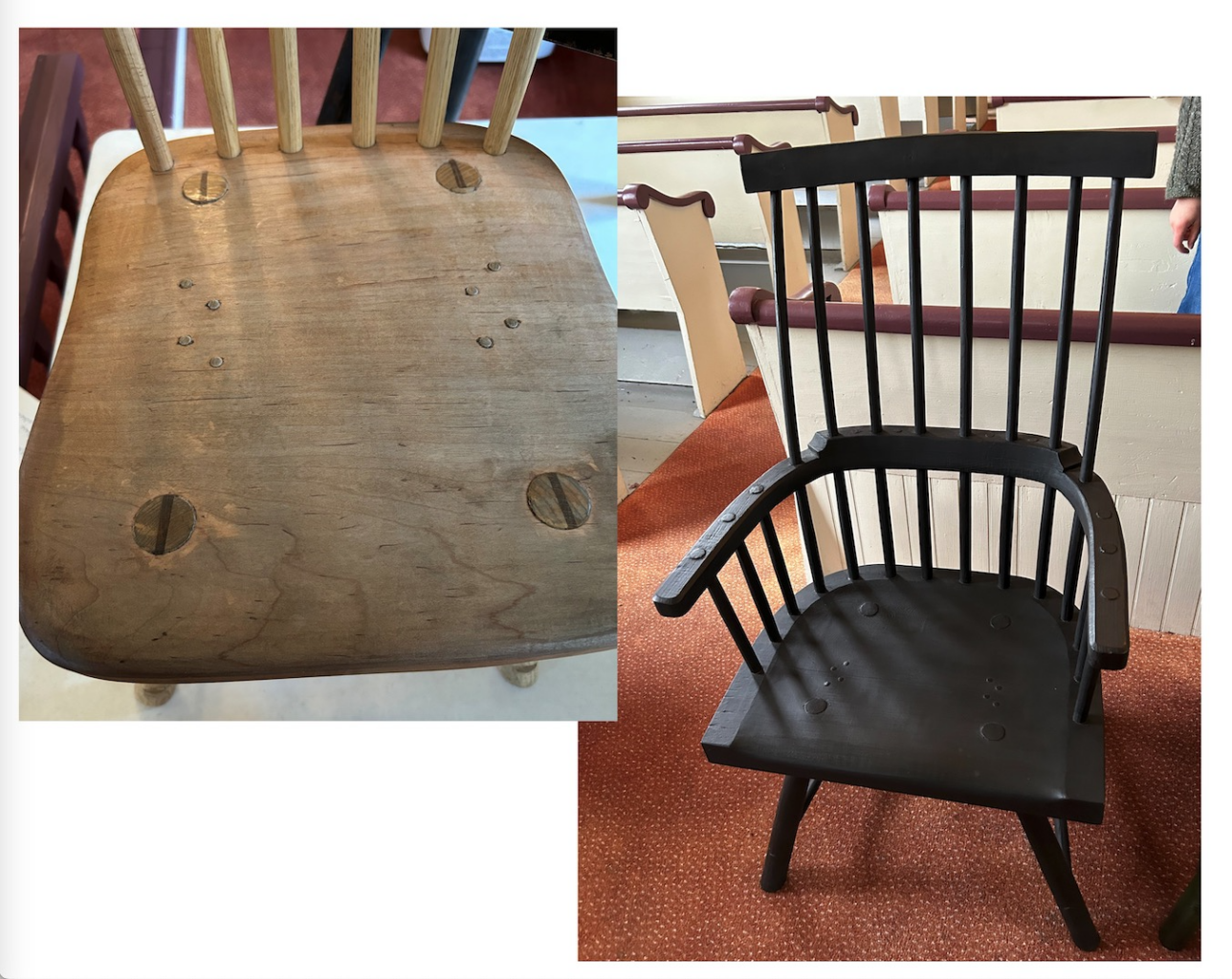
A seat made from two pieces often has pegged loose tenons.
John’s stretcher configurations are as various as the armbows. Some have none; others have stretchers on the side, back to front; still others have a medial stretcher as well, resulting in an H-shape. Several chairs have seats of white elm, which, with its interlocking grain, it is very difficult to split. “If that’s dry, and the legs are dry, and they’re driven in, and they’re wedged” it doesn’t need stretchers, says John. With a seat of ash or oak, though (eminently splittable), stretchers “just give more confidence,” to the maker and the sitter, he says

Sometimes, not usually, John leaves the tenons of the long sticks proud of the comb. (Photo by David Douyard.).
For reference, John recommends the website and Instagram of Tim Bowen Antiques. Tim and his wife, Betsan, wrote about some of the pieces that passed through their hands in The Welsh Stick Chair.3 Harvard & Harvard Antiques is another website John tracks. I found a couple of nice lobster pot chairs pictured there on a recent visit. 1stDibs, an conglomerate site of different antique dealers’ wares, often has a few good stick chairs among its offerings.
John sometimes shares a wry lament about the length of time it takes him to build a chair, but at this point in his life he’s unwilling to rush it. He does a variety of other work to make ends meet. He fixes plane totes, saw handles, infills and the like, for major antique tool dealers in the U.S. and private clients. He works on other, larger antique pieces as well. Passing through his workshop I’ve seen an original Holtzapffel lathe, with many missing pieces he had to fabricate, and a harp made in a medieval style. It had a key piece of wood the soundboard was anchored to; its grain was tearing apart under pressure of the strings, so John had figure out how to rebuild and reorient the piece, without modernizing the design. Both pieces are back in use now.
A few years back, Martin Donnelly posted a picture to a Facebook saw group that caused quite a stir. A very rare 17th-century saw was restored by John and his friend Tom Curran. After together working out how the missing piece might look, John added the wood to complete the missing section, and wood to fill old fastener holes. Tom carved the added piece in a style sympathetic to the original, and John colored the new to match the old. One of Tom’s specialties had been making beautifully worked flintlock rifles, from whence his carving skills derived.
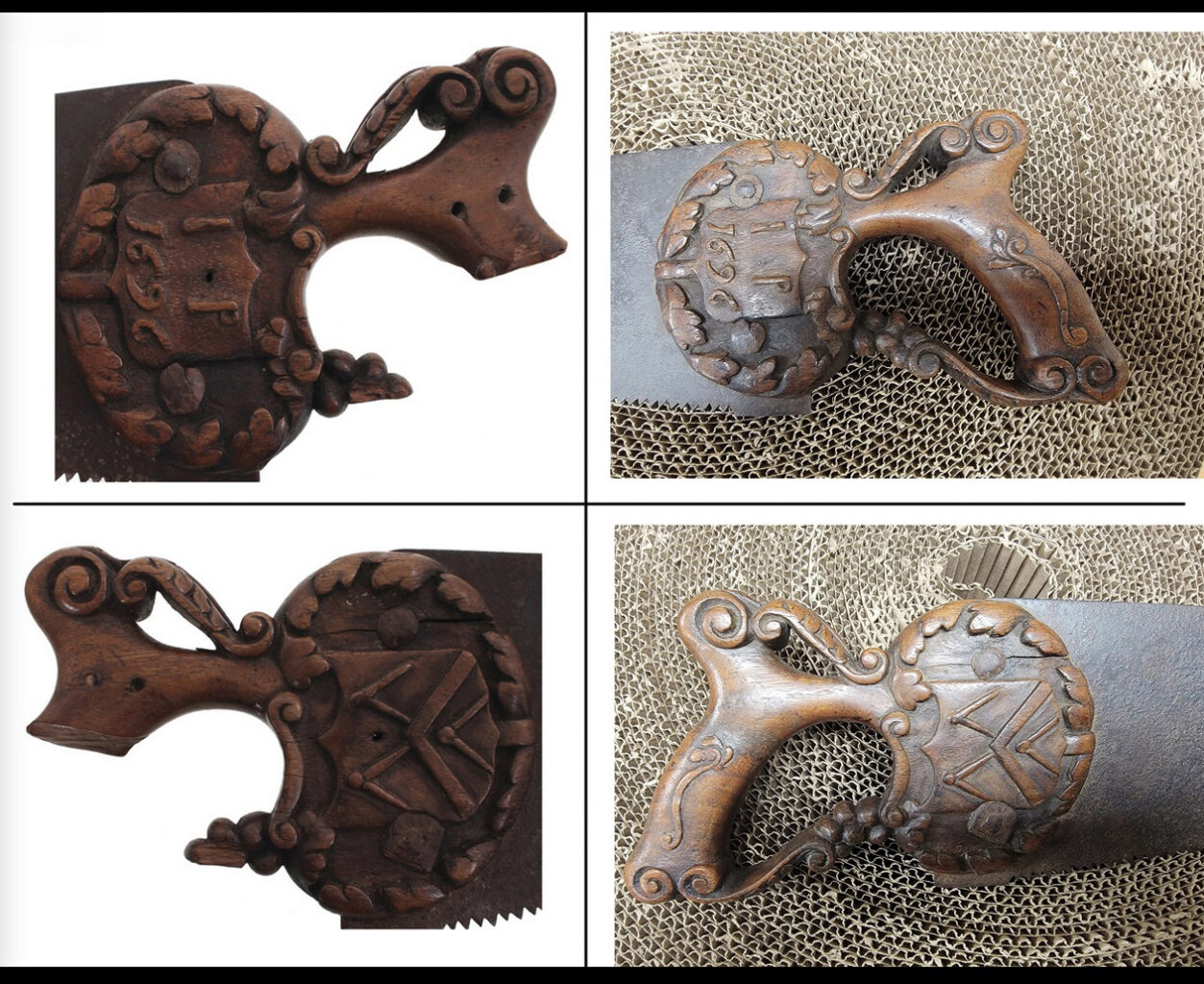
A saw handle restored by Tom Curran and John Porritt (Photo by Martin Donnelly).
John did a simpler repair to a J. Nicholls saw of mine (Nicholls was one of the mid-19th-century Philadelphia saw makers Henry Disston eventually bought out). Simpler but not simple – the large chip missing from the lower ogee curve had sprung the alignment back to front. I watched John do the repair, with minimal intrusion on the old surface, and the color matching he’s perfected over his years of working on antiques.
I’d found out John is interested in teaching, but not in travel. So I asked if we could work for a couple of days one fall. I brought two stools I’d made, and we worked on finishing them; I brought some old saws in as well, and he worked on the Nicholls while I tried fixing an old Groves saw handle.
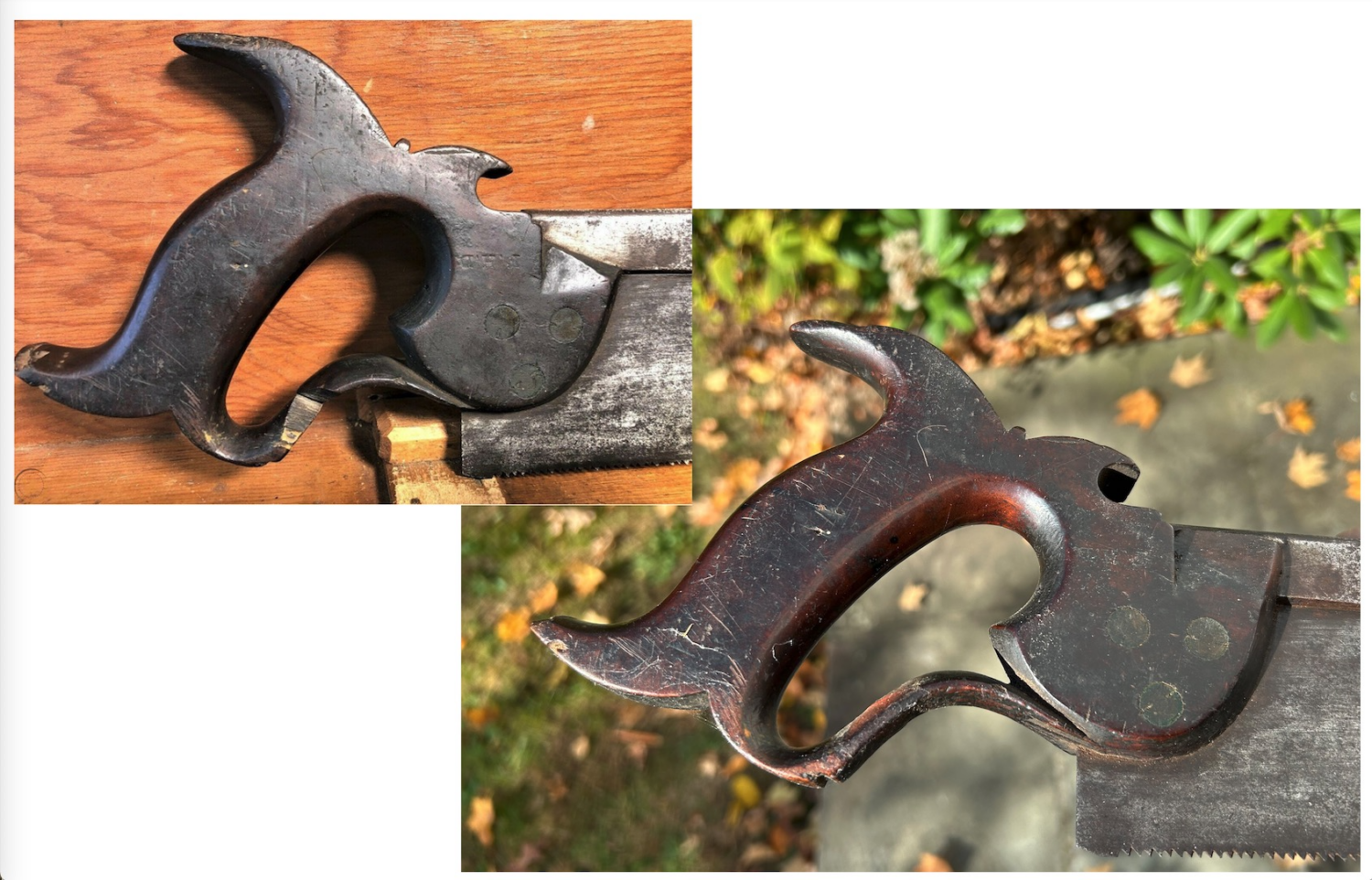
My J. Nicholls saw handle, restored by John Porritt.
There’s a sense of adventure, and play to John’s work that struck me in watching him. Once a wood repair is in place, he’ll add a stain, maybe burn it off, add another color, wipe it off, rub in some roofer’s cement, scrub it off. It’s a back-and-forth process that mimics the dings and furrows of outrageous aging. Hours are involved, but fun, too, in working toward beautifully imperfect patinated surfaces, which I think because they remind of our own temporality, and our connection to those who came before us, and those who will follow after.
Brian Crawley is a woodworker, screenwriter and award-winning playwright.
To see more of John Porritt’s work in aging a surface, check out his book, “The Belligerent Finisher” (Lost Art Press).
